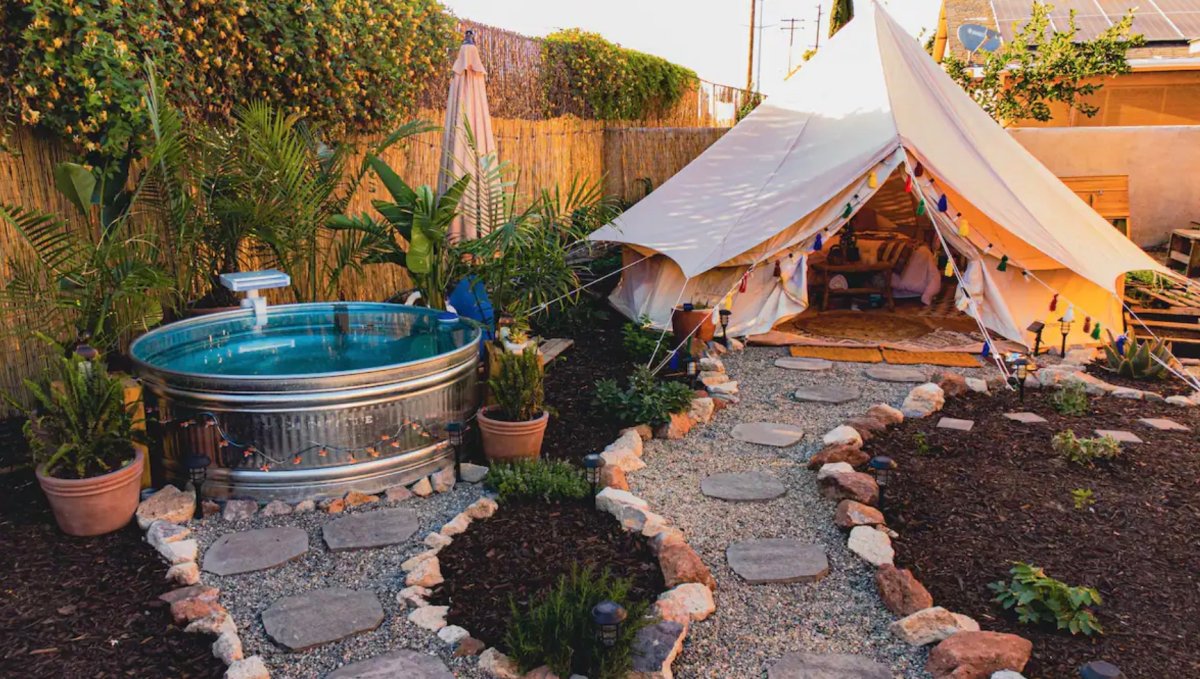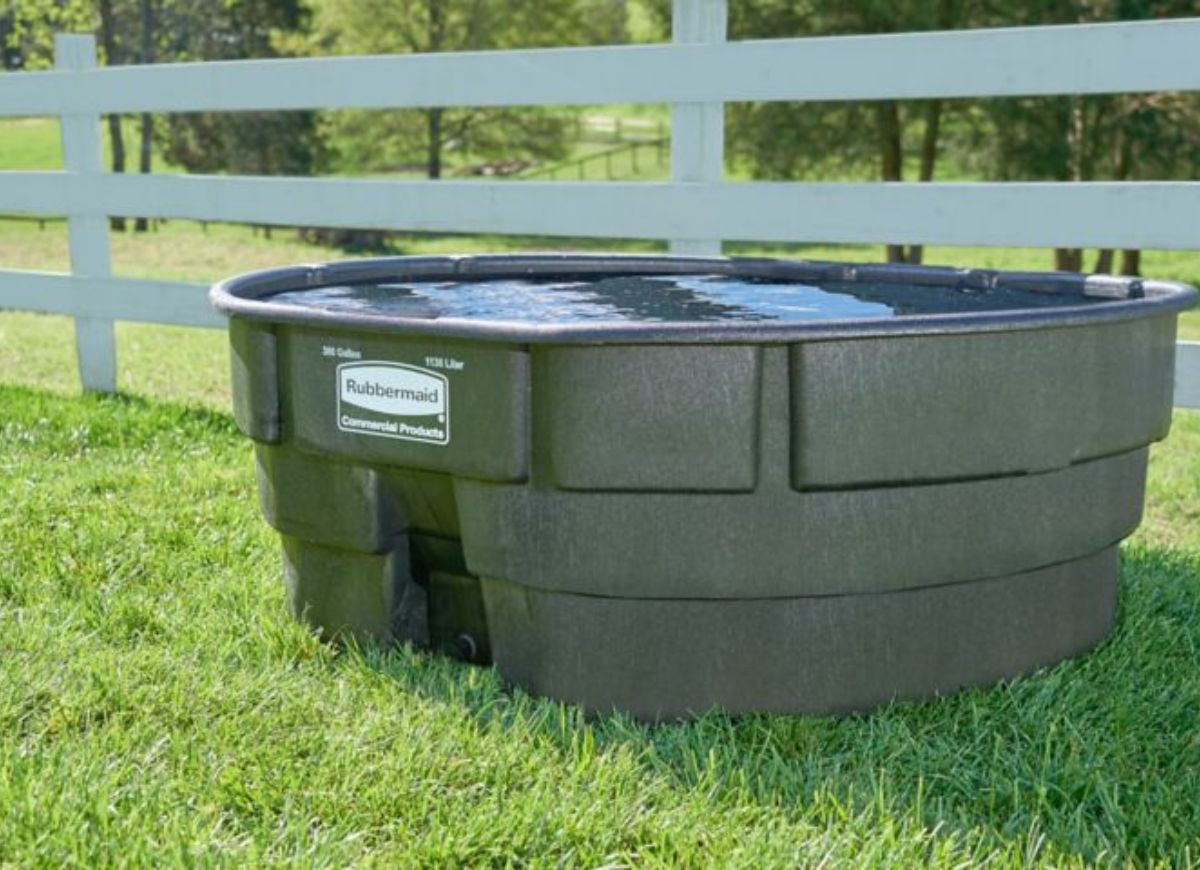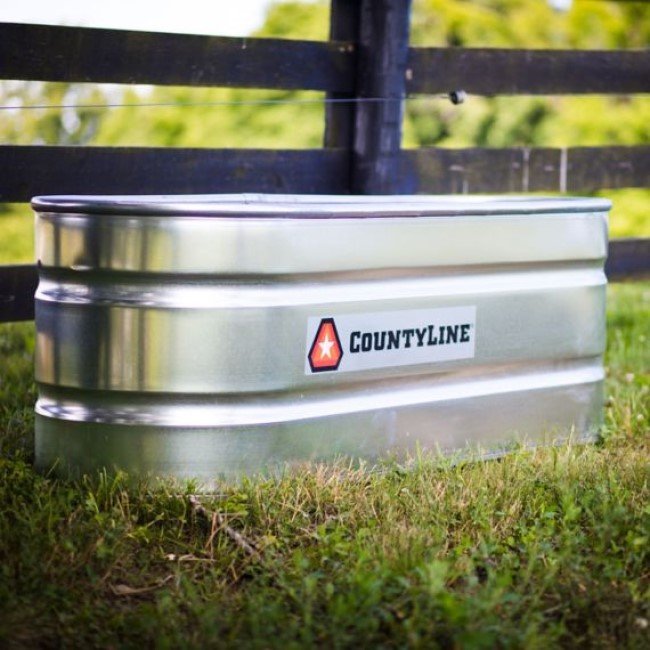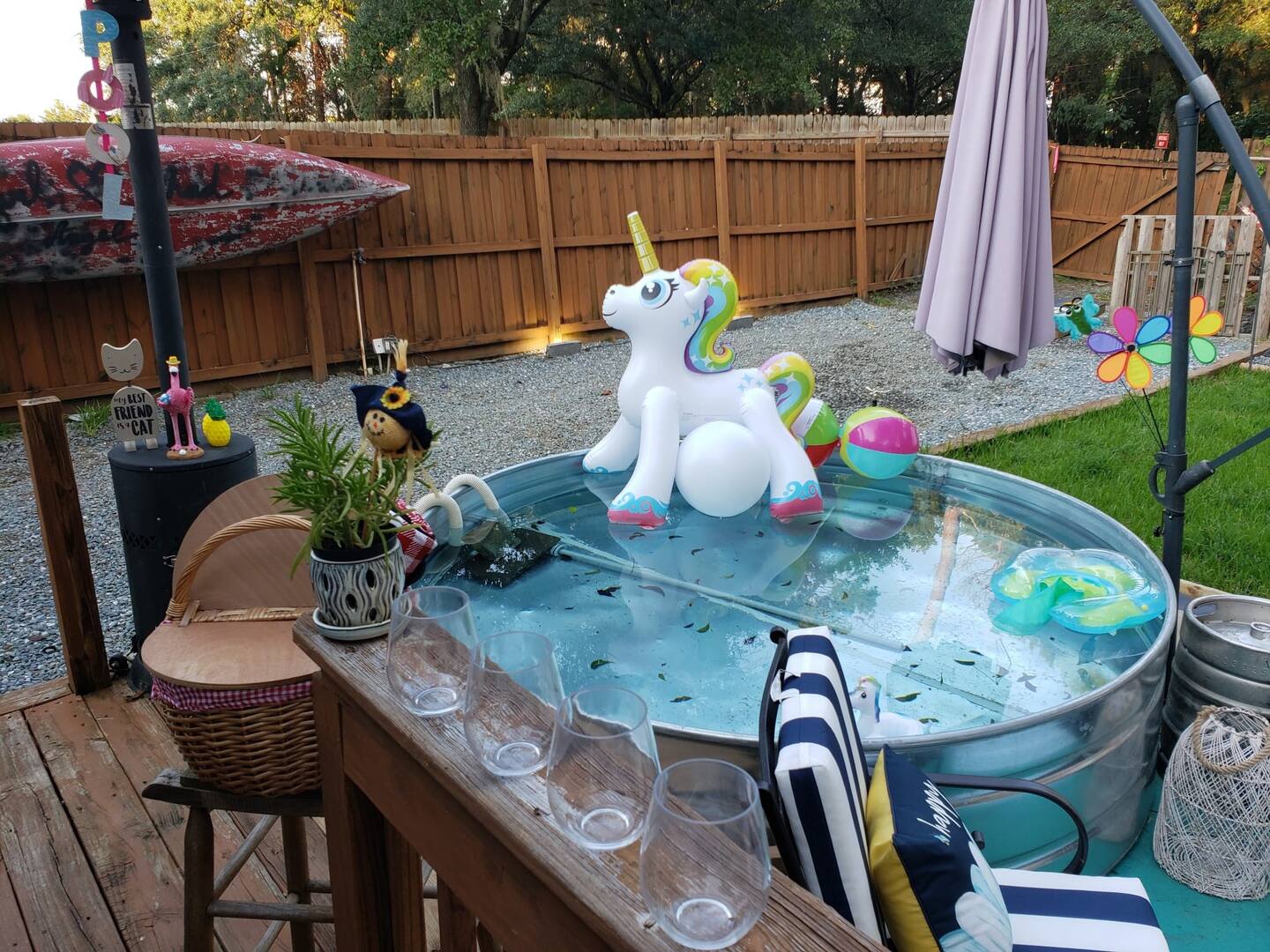

We may earn revenue from the products available on this page and participate in affiliate programs. Learn More ›
If you’ve spent any time at all on social media these past few years, you’ve probably heard stories about homeowners who have eschewed typical swimming pools and have instead set up stock tank swimming pools in their yards. These DIY pools repurpose the large containers that traditionally provide water to livestock as affordable alternatives to above-ground swimming pools. Stock tanks are widely available at tractor supply stores and are well suited for the farmhouse-rustic design trend. There are, however, several shopping and setup factors to figure out before setting up a DIY a stock tank pool in your own yard.
While an in-ground swimming pool can cost $20,000 to $65,000, and an above-ground pool can set you back about $3,000 on average, a stock tank can be had for between $200 to $450. Generally, metal tanks cost 35 percent more than plastic ones, and the larger the size and capacity, the more expensive the tank.
Cost, however, is only one concern. You’ll also need to learn maintenance practices that will ensure your water-trough pool is free of debris, human contaminants, and waterborne bacteria that can cause rashes or infections. Read on to learn what’s involved in purchasing, installing, and maintaining a stock tank pool.
First, decide where the stock tank pool should go.
Although setting up a stock tank pool is an easy enough DIY, it’s not as simple as plopping the tank down just anywhere and filling it up with water from your garden hose. You’ll need to make sure that the location can support the weight of not only the tank and water, but also of the people who will be taking a dip. The ground must also be level and free of rocks. In general, heavier metal tanks require a solid foundation like concrete and shouldn’t be set up on wooden decks, which can rot. Lighter plastic tanks may be set up on either soft or hard surfaces. For bathers’ comfort, consider situating the stock tank pool in the shade of a tree or on a covered patio to maintain a pleasant water temperature.
When choosing a location for a stock tank, keep in mind that you’ll need access to an outdoor GFCI outlet to power the stock tank’s filter. Also, make sure not to position the stock tank in a septic field, as its weight could inhibit the wastewater filtration process that takes place in the soil.
Next, determine how big a stock tank pool you need.

Tanks can range from 2 to 10 feet in length and width for square or rectangular tanks, and 2 to 10 feet in diameter for round tanks, and they can hold between 25 and 800 gallons of water. Generally speaking, stock tanks used as pools should have a length or diameter of at least 5 feet and a capacity of at least 80 gallons, which roughly equates to the size and capacity of an average bathtub.
A 400-gallon stock tank will weigh about 3,500 pounds when full, not including occupants. That’s about the weight of a midsize car, so it’s crucial to consider how much it weighs when full, especially if you plan to put it on an existing deck or to build some other structure that will be able to handle the tank, water, and bathers.
Fortunately, you can calculate a stock tank’s weight when it’s full fairly easily: Simply multiply its capacity in gallons by 8.35 pounds, which is the weight of one gallon of water, and then add in the weight of the pool itself. Once you know how much the stock tank weighs, you can make a quick calculation to determine if your deck is strong enough to hold it. (Don’t forget to add about 150 pounds per occupant.) Most decks can handle 50 pounds per square foot. With that in mind, divide the weight of the stock tank (including water and occupants) by its total area. If that number is under 50, the deck should be able to handle the weight, assuming the deck framing is in good condition.
Weigh the pros and cons of a galvanized stock tank pool versus a plastic stock tank pool, and decide which is best for your situation.
Stock tanks are manufactured of plastic (usually polyethylene) or metal (usually galvanized steel).

Plastic or poly tanks are lighter weight and thus easier to transport, and resistant to rust and corrosion. They also conduct less heat so the water stays cool longer. The downsides are they’re more likely to crack or break from a heavy impact, and their coarser surface usually demands a good deal of scrubbing to remove dirt and algae that form in the tank over time. Plus, while round and oval plastic tanks like this 8-foot by 2-foot Tarter option are self-supporting, square and rectangular models need a separate external frame to stand upright.

Galvanized metal stock tanks are heavier and more likely to rust or corrode, but they conduct more heat, warming the water fairly quickly on a sunny summer day. These tanks are also less likely to break and don’t need an external frame to stand upright, and the slick metal surfaces can easily be wiped down to remove algae. A bit trendier overall, galvanized steel tanks like this 8-foot round tub from CountyLine look chic in unfinished, galvanized steel or can be dressed up with paint.
Learn which retailers carry the best stock tank brands.
Given the trouble you’ll go to to transport and maintain a stock tank pool, you’ll want to buy a quality model that will last you a while. Pay attention to tanks’ brand names: CountyLine and Tarter make some of the best stock tanks. These tanks are made from galvanized steel that resists rusting, and they have rounded tops so there are no sharp edges that can cut people as they enter or exit the tank. If you want a stock tank that’s completely rustproof, look for a Rubbermaid plastic stock tank. Where can you buy these water troughs? You’ll likely find the widest selection at farm supply retailers, such as Tractor Supply Inc. or Southern States. Home improvement retailers such as Ace Hardware and Lowe’s have them too, but they’re usually smaller, bathtub-size stock tanks.
Once you’ve selected the right stock tank for your yard, you’ll need to figure out a way to get it home. Large 6- and 8-foot stock tanks won’t fit in the back of a pickup truck. Your best options are to have the tank delivered or rent a flatbed truck to haul it home.
Don’t forget to buy essential accessories, like pumps and filters.
You’ll need a few accessories for your stock tank in order to convert it to a pool. To maintain the pool properly, a pool pump is a must—it’ll help filter contaminants out of the water, and keep the water circulating to prevent bacteria growth. A good 500-gallon-per-hour pump, such as those made for smaller soft-sided above-ground pools, will suffice—we like a filter/pump combo, such as the Intex Filter Pump. You’ll also need the necessary pump inlet parts, which include an inlet strainer to keep large debris out of your pump and plunger valves needed for filter maintenance.
For the filter installation, you’ll need a 2 3/4-inch hole saw capable of cutting metal. Installation usually requires drilling a few holes in the tank and feeding the pump hardware into it. Attach the filter pump tubes to the hardware, fill up the pool, and then start running the pump.
Brainstorm awesome stock tank pool ideas for your property.

While stock tanks can offer a refreshing oasis from sweltering summer heat, their industrial vibe may not suit the look of your yard. There are many creative ways, though, to get a stock tank to blend in with your outdoor living space so it doesn’t stick out like a sore thumb.
One way to make a stock tank look more natural is to landscape around it with shrubs, flowers, or a water feature. You can even completely conceal the stock tank’s galvanized metal or plastic sides using hardscaping such as brick and stone. If that’s not in the budget, consider painting the stock tank in a color that blends well with your outdoor living space.
Another option is to build a deck around the stock tank. This not only changes the look of the tank but also makes it easier for bathers to get in and out. If privacy is an issue, consider adding a wooden fence adjacent to the stock tank to shield your space from your neighbors’ prying eyes.
Allow a weekend to set up a stock tank pool.
Now that you’ve chosen the perfect tank and scoped out the best site on your property, it’s time to get to work.
- Begin by leveling the land. While you may be tempted to speed through this step, failing to level the site properly before placing the tank will cause the water level to be uneven in your pool. Use a 4-foot box level to level the site and use a tamper to ensure the soil is packed down.
- Install the filter equipment by using a 2 3/4-inch hole saw to drill holes for the pool pump inlet parts, being sure to follow the instructions included with the pump. Secure the pieces using silicone caulking to prevent leaks.
- Fill the tank with water: After removing any debris from the interior of the tank with a shop vac and wiping it down, begin filling it with a garden hose.
- Add a cover: While a pool cover isn’t a requirement for a stock tank pool, it’s a smart addition. The cover can make the water warmer while keeping debris out, and it will help to maintain the proper water chemistry in the tank. There are many companies that make covers specifically designed for 6- to 8-foot-diameter tank pools and above-ground pools.
If you bought a metal water-trough pool, be ready to deal with rust.

Metal stock tank pools are susceptible to rust and corrosion when they’re full of water. The risk worsens if you drop chlorine tablets directly into the tank because chlorine reacts with water to form corrosive acids. To prevent rusting and corrosion, seal the inside of the water tank before use with a rustproof agent such as Flex Seal, or truck bed coating spray (e.g., Rust-Oleum Truck Bed Spray Coating). For additional protection, consider dispensing chlorine tablets in a slow-release chlorine dispenser like the AquaAce Floating Chlorine Dispenser.
Learn the ins and outs of maintaining a stock tank pool and keeping the water clean.
Your filter pump will remove a good deal of human contaminants and bacteria from your pool, both dead bacteria the chlorine killed and live bacteria the chlorine missed. But it won’t catch large dirt and grime deposits, which can make the pool unsightly and, when it comes to twigs and other large debris, cause injuries. Use these maintenance tips to keep your water clean and clear all summer long:
- Remove leaves, twigs, and other debris that fall into the tank with a pool skimmer daily or as needed.
- Drain the stock tank pool two to three times each season, using the drain plug that’s usually located on the bottom.
- Pressure-wash the tank each time you drain it to eliminate dirt or algae deposits that may have accumulated on the base and walls. You can rent a pressure washer at The Home Depot or invest in one of our recommendations for the best pressure washers for all of your outdoor chores.
- Use a scrub brush saturated with soapy water to loosen any stubborn grime the pressure washer didn’t catch, and then use a dry rag to wipe up the loosened material.
- When your tank is not in use, store it in a covered space (such as the garage or a shed) and cover it with a tarp to keep out bugs.
Take appropriate measures to prevent mosquitoes and algae.

Standing water, particularly the warm water found in a stock tank pool at the end of a hot day, attracts mosquitoes and the bacteria that lead to algae growth. While a filter pump will keep the water circulating, making it less hospitable to mosquitoes looking to land in it and lay eggs, you may still get biting pests buzzing around the tub.
Because draining the tank after every use to prevent standing water is wasteful (and likely to spike your water bill), hang mosquito nets from a tree or patio roof to keep the pests at bay. Likewise, use chlorine tablets (e.g., Clorox Pool&Spa XtraBlue Chlorinating Tablets) as recommended on the packaging to kill bacteria and stave off algae. With this strategy, you can keep the water in your tank cleaner longer, avoiding the need for frequent water changes.
Empty the stock tank pool when the weather turns cool.
If you live in a cold climate, it’s a good idea to empty your stock tank pool before the first freeze of the year. To empty the tank, remove the hose from the pool outlet, which will allow water to drain out of the pool. You may want to attach a garden hose to direct the water to a desired drainage area. Because most outlets aren’t at the very bottom of the pool, you’ll need to use a shop vac to suck out any remaining water. If you can maneuver it, consider turning the tank over during the off-season to prevent rainwater from collecting inside. You can also cover the pool with a tarp or a custom-made spa cover.
